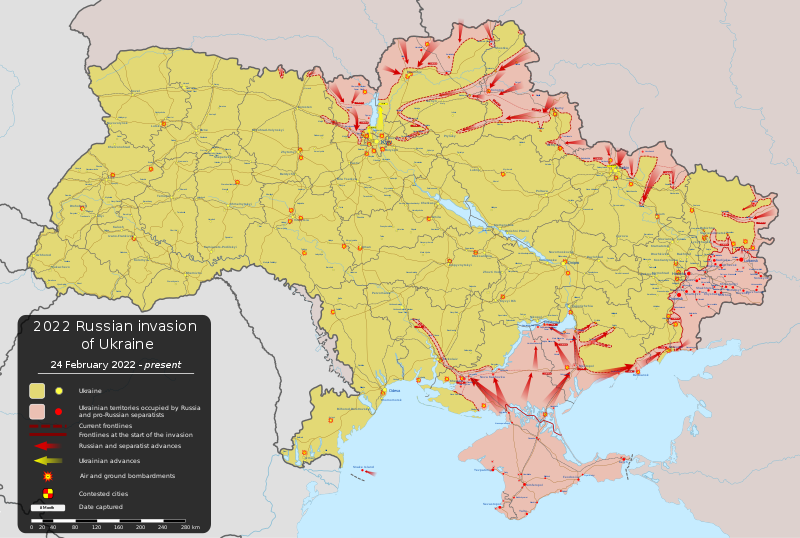The crisis in Ukraine follows patterns of history. While it has become a cliché, what’s happening now on the eastern edge of Europe echoes crises of history, particularly the Second World War.

To illustrate, this blog will compare the opening moves of those days with what’s happening in Ukraine now. I think a useful place to start is with Czechoslovakia in 1938.

As an introduction, consider Russian President Vladimir Putin’s rise to supreme, autocratic power through the first two decades of the 21st century; compare it to Hitler’s rise in Germany in the 1930s. Both leveraged illegal manipulation of government structures, rigged elections, corrupt appointment of cronies into key positions of power, military control of civilian posts, and suppression of independent media and expression.
One difference: the Russian strategy is moving much more slowly than the German did.
The table below will be moved onto its own page, “Word War III Watch,” and updated as circumstances warrant.
| Czechoslovakia 1938 | Ukraine 20th and 21st century |
| 1919: Following the end of the First World War, Czechoslovakia achieves independence from the Austria-Hungarian Empire. | December 1991: Following the disintegration of the USSR, Ukraine achieves independence, recognized by the international community. |
| 1921: Czechoslovakia, Romania and Yugoslavia ally in the “Little Entente” against Hungarian efforts to reclaim areas lost after the First World War. 1933: Sudeten German political parties in Czechoslovakia ally with Nazi party in Germany. | December 1994: Ukraine signs the Budapest Memorandum on Security Assurances, agreeing to abandon its nuclear arsenal on condition that Russia and other signatories agree not to use threats or force against its political independence or territorial integrity. Other signatories include the United States, the United Kingdom, Russia, Belarus and Kazakhstan. |
| 1935: Pro-democratic, -tolerance and -multicultaralsim Edvard Benes elected President of Czechoslovakia, opposed by Sudeten Germans and Nazi Germany. | 2004: Orange Revolution: despite assassination attempt by poison, pro-European Victor Yushchenko elected President of Ukraine, against Russian objections. Ukraine increases cooperation with NATO. |
| March 1938: Anschluss, annexation of Austria by Nazi Germany. | [Out of chronology, but logical parallel]: 2014: Russia annexes Crimean Republic. |
| 24 April 1938: Sudenten German Party (SdP) leader Konrad Henlein, after meeting with Adolf Hitler, demands autonomy for the Sudentenland, the area in northern and western Czechoslovakia, allowing the area to align with Nazi Germany. | |
| 30 May 1938: Hitler signs secret directive for war against Czechoslovakia | September 2013: Russia warns Ukraine against free trade with the EU, and announces support for Russian-speaking separatist movements in eastern Ukraine. Russia revokes guarantee of Ukrainian statehood and territorial integrity if pro-Russian regions appeal for aid. |
| February 2014: Euromaidan protests in Kyiv against Ukrainian President Yanukovich lead to Revolution of Dignity, overthrow of Yanukovich government and election of Petro Poroshenko in May. | |
| 2014: Russia begins secret financing of pro-Russian parties in Donetsk, Kharkiv, Zaporizhia and Odessa. | |
| September 1938: Adolf Hitler, Chancellor of Germany, demands control of the Sudetenland. | Early 2014: Russian President Vladimir Putin describes Donbas region of eastern Ukraine as part of Novorossiya, or “New Russia.” |
| September 1938: Germany amasses military forces along Czechoslovak border | |
| 15 September 1938: Adolf Hitler meets with UK PM Neville Chamberlain and claims that Czechoslovakia is slaughtering Sudeten Germans. | |
| 29 September 1938: UK, Germany, Italy and France sign Munich Agreement—without participation of Czechoslovak government—which forces Czechoslovakia to cede the Sudentenland to Germany. | |
| November 1938: Czechoslovakia cedes Sudentenland to Germany, southern Slovakia and Carpathian Ruthenia to Hungary, and Zaolzie to Poland. | February 2014: Russian troops and special forces invade Crimean peninsula, capture the Crimean Parliament and raise the Russian flag. |
| November 1938 to March 1939: 150,000 refugees flee from Sudetenland to what remains of Czechoslovakia | |
| 14 March 1939: Slovak Diet declares independent Slovak Republic. | March 2014: Declaration of Luhansk People’s Republic and Donetsk People’s Militia in Donbas region of eastern Urkaine by Russian-speaking separatists. |
| 15 March 1939: Carpatho-Ukraine declares independence, and is immediately occupied and annexed by Hungary. | Armed conflict begins in eastern Ukraine between Russian-back separatists and the Ukrainian government. |
| And also on 15 March 1939: German troops occupy remaining areas of Czechoslovakia. | Russian deploys up to 40,000 troops along Ukraine’s eastern border. |
| 16 March 1939: Adolf Hitler proclaims German protectorate of Bohemia and Moravia from Prague Castle. | June 2014: Russian forces move into Donetsk and Luhansk cities. |
| August 2014: Ukrainian “anti-terrorist operation” regains control of large sections of Donbas. DPR leaders beg for Russian intervention. | |
| January 2022: pro-Russian voices in Luhansk and Donetsk complain about Ukrainian aggression. | |
| 2021– January 2022: Russia masses troops and military equipment along border with Ukraine | |
| February 2022: Russia recognizes “free states” of Luhansk and Donetsk | |
| 1 September 1939: Still unopposed militarily, Nazi Germany invades Poland. This “officially” begins the Second World War as France and the UK honour their treaties to defend Poland and declare war on Germany. However, they take no action before Germany and the USSR partition Poland between them. | February 28, 2022: Russia forces invade Ukraine |
